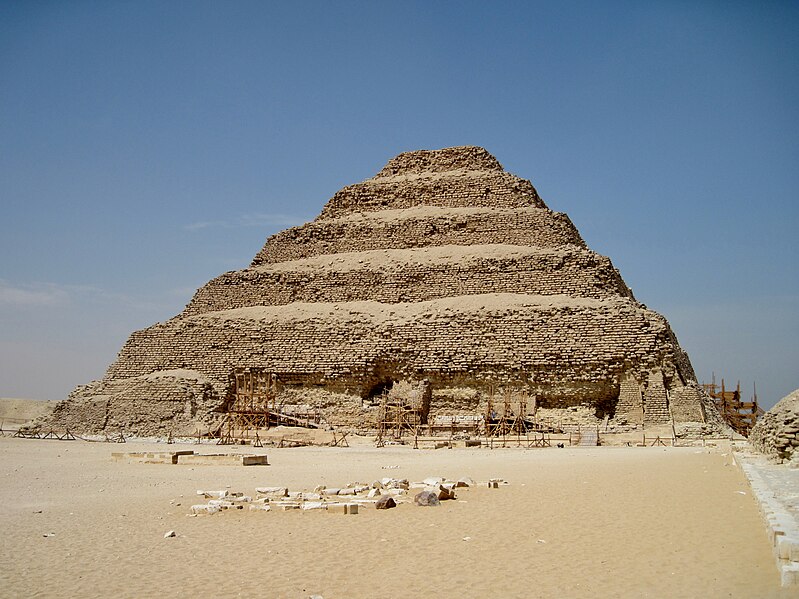Facts for Kids
The Pyramid of Djoser, also known as the Step Pyramid, is an ancient pyramid in Saqqara, Egypt, built as a tomb for Pharaoh Djoser and designed by Imhotep.
Overview
Cultural Impact
Historical Context
Visitor Information
Architecture And Design
Construction Techniques
Artifacts Found At The Site
Comparison To Other Pyramids
Significance In Ancient Egypt
Modern Archaeological Discoveries
Preservation And Restoration Efforts

Inside this Article
Creativity
Limestone
Discovery
Afterlife
Egyptian
Medicine
Thought
Pyramid
Erosion
Djoser
Time
Did you know?
🇪🇬 The Pyramid of Djoser is the first pyramid ever built in Egypt!
🏗️ It was designed by a brilliant architect named Imhotep.
📏 The pyramid is about 62 meters tall, like a 20-story building!
🚪 There are over 40 false doors surrounding the pyramid that helped Djoser’s spirit.
🪨 Workers used giant limestone blocks to build this amazing structure.
☀️ The pyramid shows how important the afterlife was to ancient Egyptians.
🏺 Archaeologists found pottery, jewelry, and tools around the pyramid.
🛡️ Many preservation efforts have helped keep the pyramid safe over the years.
🌍 Visitors can go to Saqqara to see the Pyramid of Djoser.
🌟 The pyramid has inspired legends, movies, and artwork throughout history.
Introduction
️
Cultural Impact
It inspired many legends and stories in ancient Egypt and beyond. Artists have created paintings and sculptures of the pyramid, and it’s featured in many movies. Even today, people marvel at this giant structure and its history. Many believe its design influenced later pyramids. 🚀
It reflects the creativity and engineering skills of ancient Egyptians, teaching us about their lives and beliefs. This incredible monument remains a symbol of human achievement!
Historical Context
Imhotep, the architect, was so admired that people considered him a god of medicine after his death. His design helped shape Egypt’s future buildings!
Visitor Information
The site is open to tourists, but it's good to check for any closures or rules before your visit. Be sure to wear comfortable shoes because you'll walk around a lot! 🥾
Don't forget your camera to capture this amazing wonder. Remember to respect the area, as it’s a vital part of history. With a little luck, you might spot some ancient Egyptian cats running around! 🐱
Architecture And Design
Each layer is smaller than the one below it, creating a staircase effect. Surrounding the pyramid are amazing structures, including temples and courtyards. There’s even a wall with over 40 false doors! 🚪
These doors were a way for Djoser’s spirit to move in and out. The pyramid is filled with hidden rooms and passages, like a treasure hunt! 🗝
️
Construction Techniques
They had to lift and move these heavy stones! The Egyptians used ramps made of mud and sand to help them transport materials and shape the pyramid. 🛠
️ Cleverly, they planned the structure so it stayed stable for thousands of years. Workers worked in teams and lived in nearby villages, showing incredible teamwork! They believed building the pyramid was a way to honor the pharaoh and help him in the afterlife. 👷
♂️
Artifacts Found At The Site
Some include pottery, jewelry, and tools! These items give us clues about how ancient Egyptians lived and their daily activities. They even found statues of Djoser himself, showing how important he was. Additionally, the discovery of offerings like bread and beer shows that they believed in providing for the pharaoh in the afterlife!🍞🍺 Each artifact helps tell the story of ancient Egyptian life and their fascinating customs!
Comparison To Other Pyramids
️ The famous Giza pyramids, built later, have a smooth triangular shape, unlike Djoser’s staircase design. The Great Pyramid of Giza was built about 100 years after Djoser’s and is much taller! Comparatively, the Step Pyramid started a new era in pyramid design, leading to the more famous shapes we see today. ⏳
Each pyramid tells a different story, but they all showcase the incredible skills of ancient Egyptian builders! 🌌
Significance In Ancient Egypt
️ It represented the pharaoh’s journey to the afterlife, which was a big deal to them. They thought that when a pharaoh died, he would enter another world. The pyramid was not just a tomb, but a place for Djoser to connect with the gods! This design also influenced countless other pyramids, making it a symbol of ancient Egyptian power and culture. 🏺
The pyramid helped people understand how important life after death was in Egyptian beliefs!
Modern Archaeological Discoveries
️♂️ Using new technologies like ground-penetrating radar, they can find hidden rooms and passages without digging. Recently, they’ve found important burial sites and ancient artifacts that tell us more about Djoser’s time. 🔍
Every finding helps us understand how ancient Egyptians lived, worked, and thought. These discoveries remind us that history is still alive—and that there’s always more to learn about the amazing pyramids! 🏺
Preservation And Restoration Efforts
️ In the past, natural erosion and human activities caused damage to the pyramid. Egyptian authorities and restoration experts have worked hard to protect and preserve it. This includes reinforcing weak areas and cleaning the stones. 🧹
They even made pathways for visitors to help keep the site clean. These efforts ensure that future generations can learn and enjoy this piece of history. 🌍

